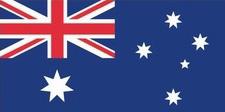Request a Flag
The Australian National Flag is Australia’s foremost national symbol. It was first flown in 1901 and has become an expression of Australian identity and pride.
The Australian National Flag flies over the federal and state parliaments. The flag is paraded by our defence forces and displayed around the country at sporting events and by service organisations, schools, community groups and private citizens.
The Australian National Flag has three elements on a blue background: the Union Jack, the Commonwealth Star and the Southern Cross.
The Union Jack in the upper left corner (or canton) acknowledges the history of British settlement.
Below the Union Jack is a white Commonwealth or Federation star. It has seven points representing the unity of the six states and the territories of the Commonwealth of Australia. The star is also featured on the Commonwealth Coat of Arms.
The Southern Cross is shown on the fly of the flag in white. This constellation of five stars can be seen only from the southern hemisphere and is a reminder of Australia’s geography.
History
The colonies of Australia federated to become a single Commonwealth in 1901. That year, Australia’s first Prime Minister, the Rt Hon Sir Edmund Barton announced an international competition to design a flag for the new nation. It attracted 32,823 entries. Five near-identical entries were awarded equal first and the designers shared the £200 prize.
The Australian National Flag was flown for the first time in September 1901 at the Exhibition Building in Melbourne, which was then the seat of the federal government.
It was announced in Commonwealth of Australia Gazette No 8 of 1903 that King Edward VII approved designs for the flag of Australia, known as the Commonwealth blue ensign, and for the flag of the merchant navy, known as the Commonwealth red ensign. The stars of the Southern Cross were simplified to four seven-pointed stars and one five pointed star. (The 1901 design depicted the stars with a differing number of points to signify their brightness.) In 1908 a seventh point was added to the Commonwealth star to represent the Australian territories.
Confusion developed surrounding the use of the two Australian flags. The blue ensign was intended for official and naval purposes only and the red ensign was to be used by the merchant fleet. However, the general public also began using the red ensign on land. In 1941, Prime Minister the Rt Hon Robert Menzies issued a press statement recommending the flying of the blue ensign as a national emblem. The Flags Act 1953 ended confusion about which ensign to use.
An amendment to the Flags Act 1953 was passed in 1998 to ensure that the Australian National Flag can be changed only with the agreement of the Australian people.
Other official Australian flags include the Australian Aboriginal Flag, the Torres Strait Islander Flag and the ensigns of the Australian Defence Force.
Proclamation
The Flags Act 1953 proclaimed the Australian blue ensign as the Australian National Flag and the Australian red ensign as the flag for merchant ships registered in Australia.
Flying the flag
The Australian National Flag can be flown every day of the year.
Your own flag
You can get your own Australian flag from my office if you're an eligible group. Please get in touch for more information.
Information courtesty of It's an Honour and the Department of the Prime Minister and Cabinet.



